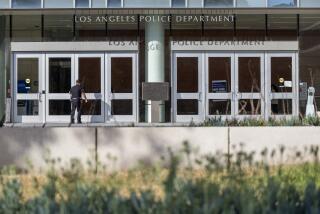To reform the Sheriff’s Dept., look to the LAPD
The recent resignation of Sheriff Lee Baca presents a much-needed opportunity for meaningful, lasting and long-overdue reform of the Los Angeles County Sheriff’s Department. The federal indictments in December of 18 former and current sheriff’s deputies are the latest and most dramatic indication of a department in desperate need of change. In charting the road for reform — with the multifaceted aims of transforming a troubling culture, institutionalizing internal structural changes and rebuilding public confidence — much can be learned from the experiences that propelled reform of the Los Angeles Police Department.
For decades, the LAPD was plagued by a culture that tolerated, and at times encouraged, civil rights violations. Every time there was a major incident of misconduct, department and city leaders said the misconduct was the result of just a “few bad apples.” A study would be done and there would be proposals for reform. Some would be adopted; most would be ignored. The problem would be deemed solved until the next incident precipitated the same pattern of responses.
This cycle ended with the Rampart scandal in 2000, which exposed officers in an anti-gang unit who planted evidence on innocent people and lied in court to gain convictions. In the wake of these revelations, the Justice Department informed city officials that it was contemplating suing Los Angeles for a pattern and practice of civil rights violations. The city entered into a consent decree that mandated many changes overseen by a monitor and a federal judge. Mayor James Hahn appointed a police chief from outside the department, William J. Bratton. Real reforms occurred and the LAPD today is a vastly different department.
Important lessons can be drawn from this experience. First, civilian oversight is essential. A police or sheriff’s department is in many ways a paramilitary organization. Civilian engagement and a transparent vehicle for accountability is critical. That means having department leadership that is held accountable for measures of progress and answerable to voices from the community who are focused on maintaining the highest standards of constitutional policing.
The path to reform at LAPD began with the Christopher Commission, which in the wake of the 1991 Rodney King beating proposed that the Los Angeles Police Commission have authority to manage the department. Voters then approved a City Charter amendment empowering the commission.
Unlike the police chief in Los Angeles, the sheriff is elected and directly answerable only to the voters. The county Board of Supervisors sets the sheriff’s budget, but it cannot manage the department or mandate full access and authority for any civilian commission. Although these constraints render a civilian oversight board less than perfect, there are still significant benefits to its creation. The supervisors should proceed down this path, even as efforts continue to create by statute the best possible authority for civilian oversight.
It is also important to bring in leadership from outside the sheriff’s office. The Christopher Commission, and every major study of the LAPD, found that the central problem was the culture of the department. Studies of the sheriff’s office have said the same thing. It is difficult for a person who is a product of that culture and environment to be the one to change it. It is not coincidental that the major changes in the LAPD occurred only after a strong leader from outside the department was appointed as its chief.
And there is great value in external standards and monitoring. The reform of the LAPD happened when the Justice Department got involved and a consent decree, with a monitor, was approved. It is difficult for a department to reform itself, especially when problems are systemic and long-standing.
Finally, it was crucial that Bratton acknowledged past problems and sincerely embraced the need for reform. Absent recognition of past problems, that troubling history is destined to repeat itself, especially when the spotlight fades. It is imperative that the next sheriff not simply be committed to reform but also be fully candid about the department’s disturbing history.
The Citizens’ Commission on Jail Violence in 2012 documented a troubling culture in the Sheriff’s Department that fostered abuse of force and allowed excessive force to continue for decades. It has crafted a detailed road map for change. But implementing this blueprint will require the right people, the right structure and the right oversight.
The experience of the LAPD shows that real reform can happen. Now it must occur in the Sheriff’s Department.
Erwin Chemerinsky is dean of the UC Irvine School of Law. Miriam Aroni Krinsky is a policy consultant for the California Endowment and served as the executive director of the Citizens’ Commission on Jail Violence.
More to Read
A cure for the common opinion
Get thought-provoking perspectives with our weekly newsletter.
You may occasionally receive promotional content from the Los Angeles Times.










